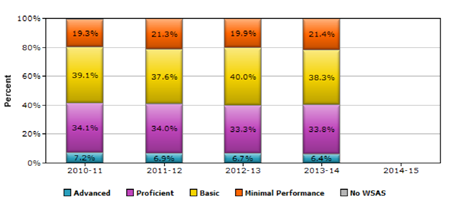|
2019 Family & Student Survey Data
2018 Family & Student Survey Data
2017 Family & Student Survey Data

|
Family & Student Surveys
Student Experiences are an indication from families on how connected their child is to his/her school. Overall Engagement is measured on a four-point scale from student responses on the annual Student Engagement Survey.
Full Definition: Whole Child education is defined as an approach to education that “focuses attention on the social,
emotional, mental, physical, as well as cognitive development of students.” The philosophy behind Whole Child education emphasizes the importance of developing students into future citizens and understanding students’ full potential in school and beyond. As such, it draws heavily on social, emotional and character development research and programs.
Data Source: Annual Family Survey and annual Student Engagement Survey.
Peer Comparison Group: None
Related & Influencing Measures: Report cards (click HERE), behavior of lifelong learners.
5-Year Target: Annual increase in the selection of strongly agree and agree on the Family Survey, and an increase in the overall score for each grade group on the Student Engagement Survey.
|
|
|
Behaviors of Lifelong Learners
Full Definition: K-5 students are assessed every trimester by a team of teachers on the following behavior
-Collaborative Worker
-Cooperates with others
-Demonstrates respect and compassion for others
-Community Contributor
-Takes responsibility for self and materials
-Accepts responsibility for actions
-Demonstrates self-control
-Participates approriately in group discussions
-Quality Producer
-Initiates and competes tasks
-Strives for accuracy and quality
-Complex Thinker
-Thinks, questions, and solves problems in a variety of ways
-Demonstrates curiosity in learning
-Demonstrates a willingness to try new experiences
Data Source: Skyward and DecisionEd
Peer Comparison Group: None
Related & Influencing Measures: Students referred for School Based Mental Health and students taking the BASC and BESS
5-Year Target: TBD
|
|
Click HERE to view e-DECA Data

|
e-DECA
e-DECA is a nationally standardized, strengths-based screening and assessment tool developed by the Devereux Center for Resilient Children for children ranging from infancy through 5 years.
Full Definition: Measures the Total Protective Factors (Initiative, Self-Control, Attachment), and Behavioral Concerns.
Data Source: e-DECA assessment system.
Peer Comparison Group: None
Related & Influencing Measures: Teacher observations.
5-Year Target: TBD
|
Click HERE to view District Attendance Data

Click HERE to view District Truancy Rates
Click HERE to view District Dropout Rates
Click HERE to view District Open Enrollment Counts |
Attendance
Attendance is the measure of the percentage of students who are in school during instruction.
Full Definition: Attendance is a measure, by percentage, of students being in school during instruction. It does not focus on why students are absent, and recognizes taht regardless of the reason for absences, students need to be in school to learn.
Data Source: Skyward
Peer Comparison Group: None
Related & Influencing Measures: Student Engagement Survey.
5-Year Target: 95% attendance rate or higher.
|
Click HERE to view Discipline Data
 |
Discipline Data
In-school and out-of-school suspensions, and 5-year discipline data are indicators of maintaining safe and supportive learning environments.
Full Definition: In-school and out-of-school suspensions measure the number of times students have been removed from their regularly scheduled class. The 5-year trend of discipline data indicate the types of infractions taking place on ECASD campuses.
Data Source: Skyward.
Peer Comparison Group: None
Related & Influencing Measures: SWIS/PBIS data.
5-Year Target: TBD
|
| Click HERE to view District *Athletic Extra-Curricular Activities Counts |
Extra-Curricular Activities |